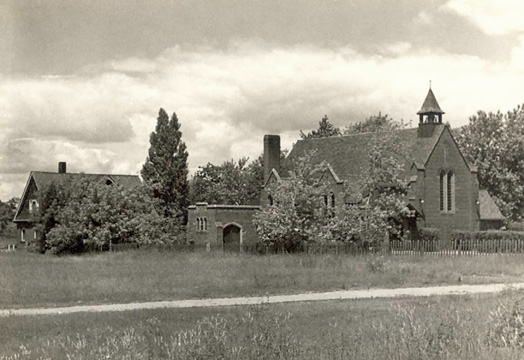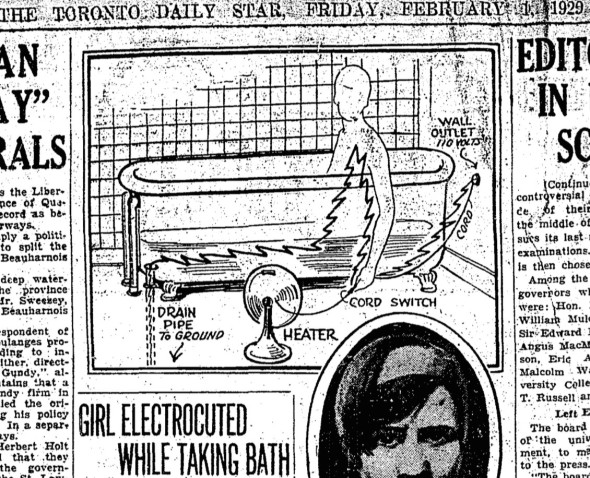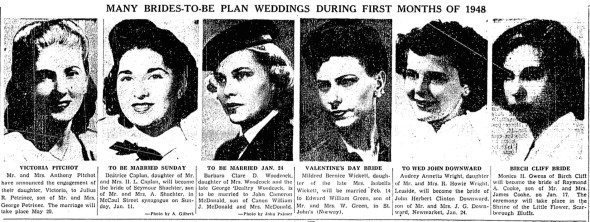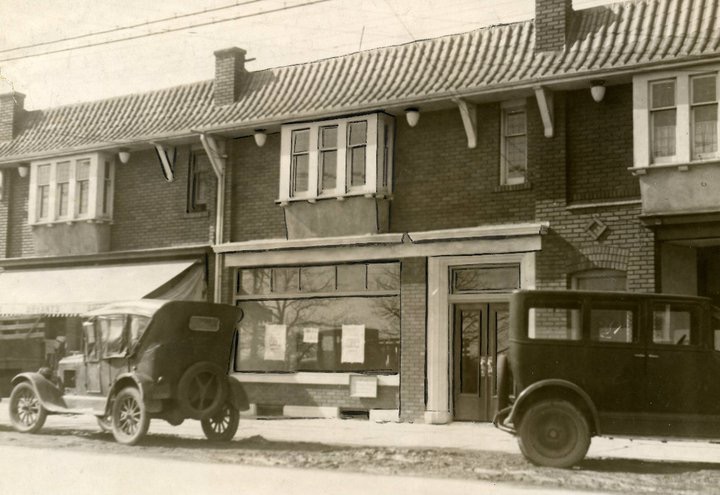It takes some imagination to visualize what life was like in Birch Cliff 80 or 90 years ago.
Kingston Road was a two-lane dirt road, oiled and sanded on a regular basis, and primarily used by radial cars that were heated with coal-fired pot belly stoves.
It was in 1911/1912 that Toronto Hydro started bringing electricity to residential streets. Around that time, however, most houses were still heated by coal and it’s estimated that average residential use was five to seven tonnes per typical winter.
It wasn’t until the 1920s that people started to enjoy modern conveniences like domestic electrical appliances.
It could be considered a sign of the times then that the following story was prominently published in the Toronto Daily Star on Feb. 1, 1929.
It’s a tragic story about a young girl, a bathtub and an electric heater from an era when people were still learning about the dangers of electricity.
~~~~~~~~~~~~~~~~~~~~~~~~~~~~~~~~~~~~~~~~~~~~~
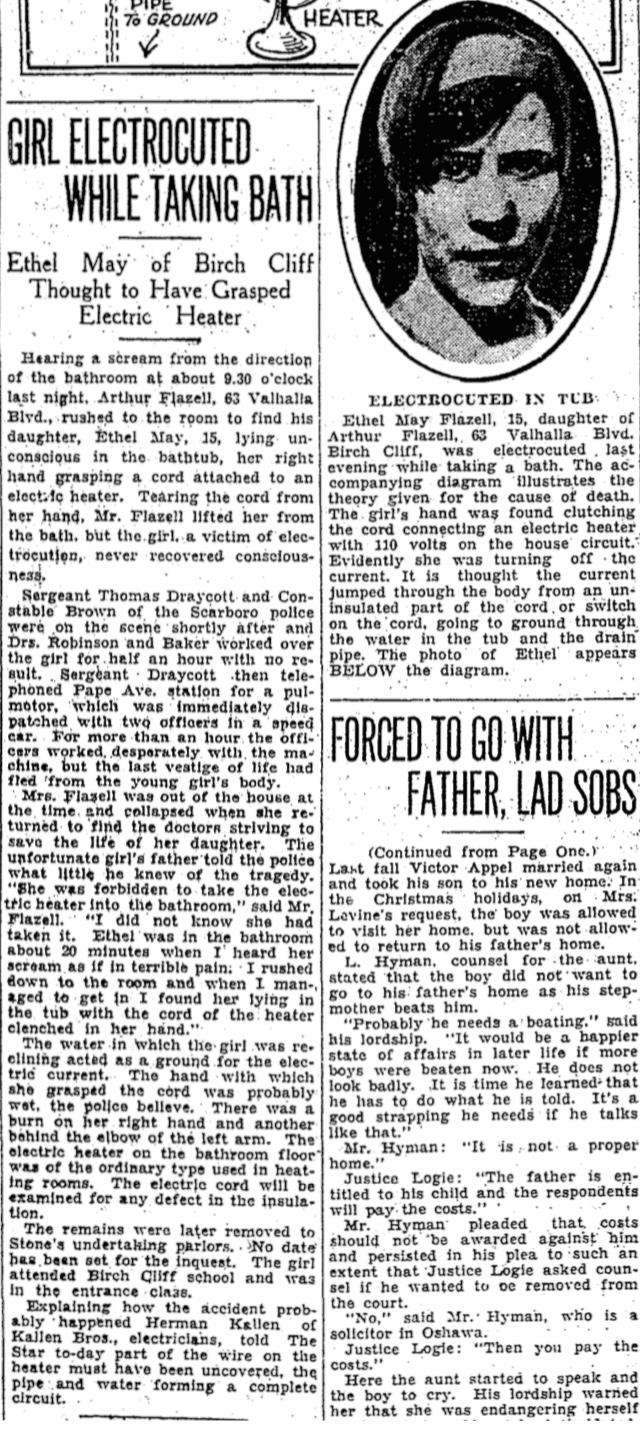 Girl Electrocuted While Taking Bath
Girl Electrocuted While Taking Bath
Hearing a scream from the direction of the bathroom at about 9.30 o’clock last night, Arthur Flazell, 63 Valhalla Blvd., rushed to the room to find his daughter, Ethel May, 15, lying unconscious in the bathtub, her right hand grasping a cord attached to an electric heater. Tearing the cord from her hand, Mr. Flazell lifted her from the bath but the girl, a victim of electrocution, never recovered consciousness.
Sergeant Thomas Draycott and Constable Brown of the Scarboro police were on the scene shortly after and Drs. Robinson and Baker worked over the girl for half an hour with no result. Sergeant Draycott then telephoned Pape Ave. station for a pulmoter, which was immediately dispatched with two officers in a speed car. For more than an hour the officers worked desperately with the machine but the last vestige of life had fled from the young girl’s body.
Mrs. Flazell was out of the house at the time and collapsed when she returned to find the doctors striving to save the life of her daughter. The unfortunately girl’s father told the police what little he knew of the tragedy.
“She was forbidden to take the electric heater into the bathroom,” said Mr. Flazell. “I did not know she had taken it. Ethel was in the bathroom about 20 minutes when I heard her scream as if in terrible pain. I rushed down to the room and when I managed to get in I found her lying in the tub with the cord of the heater clenched in her hand.”
The water in which the girl was reclining acting as a ground for the electric current. The hand with which she grasped the cord was probably wet, the police believe. There was a burn on her right hand and another behind the elbow of the left arm. The electric heater on the bathroom floor was of the ordinary type used in heating rooms. The electric cord will be examined for any defect in the insulation.
The remains were later removed to Stone’s undertaking parlors. No date has been set for the inquest. The girl attended Birch Cliff school and was in the entrance class.
Explaining how the accident probably happened Herman Kallen of Kallen Bros., electricians, told The Star today part of the wire on the heater must have been uncovered, the pipe and water forming a complete circuit.
Diagram accompanied news story
It’s not clear how prevalent electrocution was in Canada at the time when household appliances were gaining popularity but the fact that the story was featured so prominently in the Toronto Star might reflect the unexpected nature of the incident.
Interestingly, the newspaper felt that the article needed to be accompanied by a diagram illustrating the theory given for the cause of death.
When Birch Cliff was prominently mentioned in newspapers
The newspaper’s prominent placement of the sad story about Ethel May reinforces the impression that Birch Cliff was featured more regularly in the Toronto newspapers in the early half of the 20th century than it is today. (Have you ever told someone you live in Birch Cliff and gotten a blank stare in response?)
This is likely due to the fact that Birch Cliff, which was established around 1908, was the Scarborough suburb closest to Toronto and the most developed, with the Scarboro Municipal Council holding its meetings in the former bank building at the corner of Kington Rd. and Birchcliff Ave.
Research for this Today in History series undercover a surprising number of references to Birch Cliff in the Toronto Star archives, such as this story from Jan. 15, 1948.
The major Toronto dailies, however, didn’t just cover tragedy. Check out this story from Nov. 13, 1929 celebrating the winners of the speech competition at Birch Cliff Public School.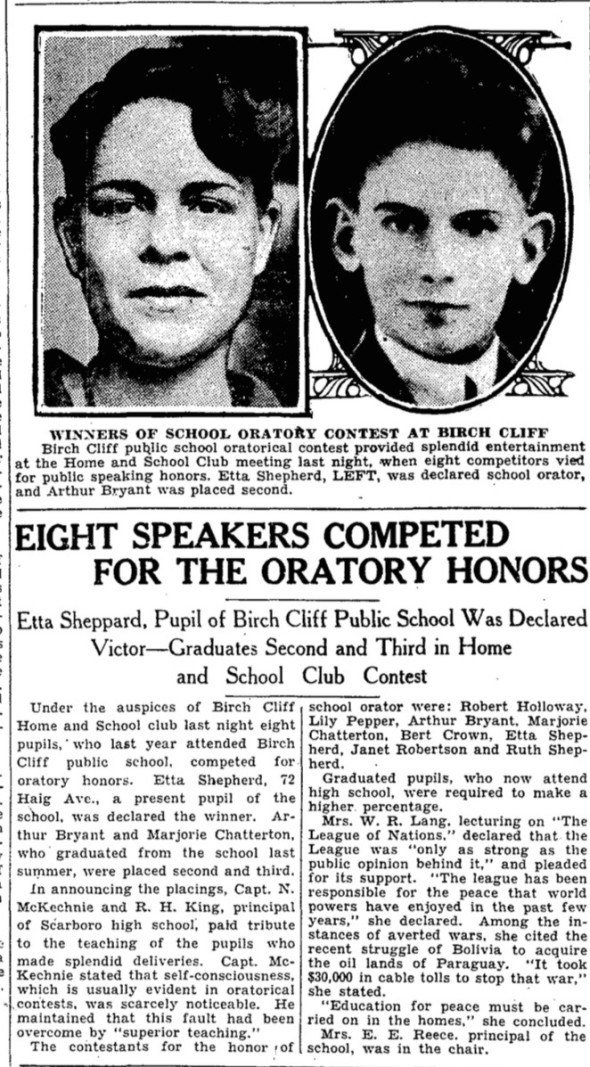
And here’s something you don’t see any more – “brides-to-be” from the Jan. 8, 1948 edition of the Toronto Star, including a “Birch Cliff Bride”.
This is part two of a new “Today in History” series commemorating the upcoming 100th anniversary celebration of Birch Cliff Public School, which is taking place on Sept. 23/24, 2016. You can check out part one here.

